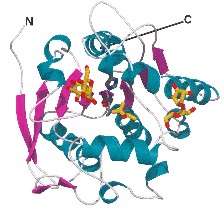Prostate Cancer Screening Tests – Part 1

Prostate Specific Antigen (PSA) has a long history as a blood screening test for prostate cancer. But because of it’s limitations and relative low sensitivity there has been a move to find better screening markers for Prostate cancer. It is well known that PSA can be elevated for reasons other than prostate cancer. These other markers also have limitations but have better parameters in sensitivity, specificity, and predictive values.
Age Specific PSA
As men age the normal range for PSA changes. In the older man a higher level PSA is acceptable relative to the younger man. This is thought to be due to benign enlargement of the prostate that occurs with age. This benign enlarged prostate release more PSA into the blood stream than a benign smaller prostate.
Acceptable age ranges have been established (see chart below)
up to Age 49 0-2.5
50-59 0-3.5
60-69 0-4.5
70+ 0-6.6
(Reference -Oesterling JE, Jacobsen SJ, Chute CG, et al: Serum prostate-specific antigen in a community-based population of healthy men: Establishment of age-specific reference ranges. JAMA 270:860-864, 1993. )
Even with this data, institutions have established their own age specific guidelines and follow up protocols. In their analysis a variation on the national recommendation is better for their population of patient. (example: http://www.mskcc.org/cancer-care/adult/prostate/screening-guidelines-prostate )
Percent Free and total PSA
PSA is a serine protease that floats freely or is bound to different proteins in the blood. The ratio of free to bound PSA seems to differ in men who have elevated PSA due to either benign or malignant disease. Doctors look at the ratio and use this to help decide whether to recommend a biopsy. The lower the percent free PSA the more likely the elevated PSA is due to prostate cancer. The higher the percent free PSA the more likely the elevated PSA is due to benign disease. (see stratification chart below)
| Free:total PSA ratio | 50-59 years | 60-69 years | > or =70 years |
| < or =0.10 | 49.2% | 57.5% | 64.5% |
| 0.11-0.18 | 26.9% | 33.9% | 40.8% |
| 0.19-0.25 | 18.3% | 23.9% | 29.7% |
| >0.25 | 9.1% | 12.2% | 15.8% |
(Oesterling et al. J. Urol 1995;154:1090-1095)
This test has found it’s use most valuable in patients whose native PSA is in the 4-10 range. The dilemma in these patients is that they have a 25% chance of having prostate cancer but the corollary is that they have a 75% chance of NOT having prostate cancer. Therefor, if they are to have a biopsy looking for prostate cancer then 3/4 would have a no cancer. This test is used in men with PSA in this range to better delineate whether they are more or less likely to have elevated PSA due to malignant disease as opposed to benign issues.
PSA Velocity
We have discussed how PSA increases as men age but we also know that PSA increases as prostate cancer grows in men with cancer. How do we distinguish a “normal” rising rate vs. a “cancerous” rising rate? This question was address in the classic study, Baltimore Longitudinal Study of Aging, from Johns Hopkins University. This study followed many men for years checking PSA on regular intervals. It suggested that for men with PSA of 4-10 a PSA velocity of 0.75ng/ml/year was predictive of a higher risk of prostate cancer. Because of individual variation in PSA they determined the PSA’s must be drawn over a two year period with at least three data points. If the PSA was <4 then a rate of >0.35ng/ml/year should be used (J Natl Cancer Inst 2006;98(21):1521-1527).
In contrast to the above data and NCCN recommendation, a more recent study from Memorial Sloan Kettering Cancer institute reported that PSA velocity did NOT enhance the ability to diagnose prostate cancer and by adding PSA velocity to the current screening approach only added minimal improvement in prostate cancer detection. They found by using this criteria that for about ever five men biopsied only one would detect prostate cancer (J Natl Cancer Inst 2011;103(6):462-469) and by decreasing the threshold PSA from 0-2.5 would be a better predictor of prostate cancer.
With this and many other screening test controversies, the best approach remains a multifaceted approach. You should have a discussion with your Urologist about the benefits and deficits of screening and possible biopsy based on your individual situation.
Tags: cancer screening, Prostate cancer, Prostate cancer diagnosis, Prostate Cancer screening, prostate specific antigen, PSA
